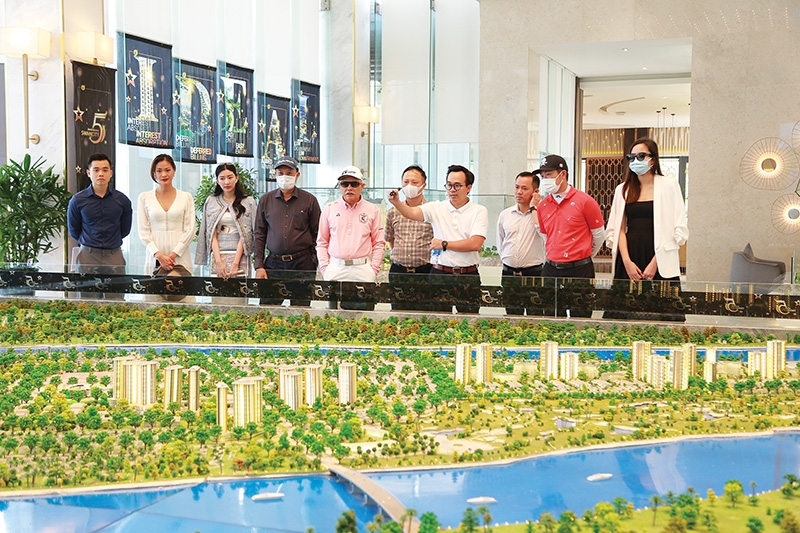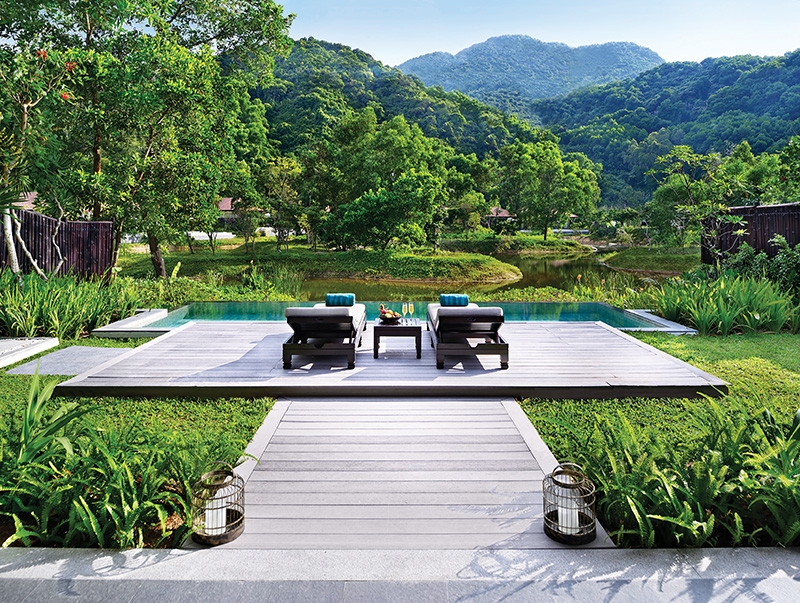Island properties driving interest of high-class buyers
 |
| The pandemic has not slowed down interest from buyers and developers for top-class properties |
On a breezy Saturday evening in Nhon Trach district of Dong Nai province, a group of residents were enjoying a BBQ dinner outside a garden villa at SwanBay, a township developed on Dai Phuoc island, 30 minutes by boat from Ho Chi Minh City.
“It is ideal to have a villa on the island. I had heard about the concept of island properties, and now I can have such a villa right here in Vietnam,” said the owner.
Beginning in 2017 as a project totalling over 200 hectares, half of which has already been developed, Swanbay boasts over 2,000 units sold and 1,000 of them already completed and handed over.
The project is among some of the first to be developed under the concept of island townships in Vietnam. Also in the same province, other ventures such as Angel Island by Song Tien Corporation and Aqua City-Phoenix developed by Novaland are driving interest from high-income buyers.
According to Trang Bui, head of client development and transactions at JLL Vietnam, Vietnam waterfront and island properties may be one of the newest areas in the region to reach prominence, but it is far from being the only one.
Before the pandemic hit, the Asia-Pacific was in the midst of an urban waterfront building boom, as developers crowd in to get a piece of coveted coastal areas from Singapore to Sydney.
While the world in general saw investment reduced sharply due to the coronavirus crisis, in Vietnam the segment remains on the radar of rich buyers thanks in part to its successful containment of the pandemic compared to many nations elsewhere.
Trang said that as local economies mature and affluence rises, these waterfront and island properties become increasingly attractive from a recreational and housing point of view.
“Island properties are offering something uniquely different from the typical inland development and they reflect the unique habit of wealthy consumers,” said Trang.
New concepts
From an urban perspective, coastal and island development has traditionally been dominated by commerce such as trading, shipping, and transportation.
According to Trang, in developed modern metropolises where green space is at a premium, however, a river or island view brings a sense of openness and a connection to the natural world that is crucial for every resident.
Waterfront locations offer residents expansive views and a resort-like lifestyle – two preferred factors for both buyers and investors. Moreover, island and waterfront properties are offering a valuable environment to its residents.
In many real estate projects, developers have to build up a friendly environment system from the ground up. Island projects, meanwhile, already inherit a rich bio-diversified environment, meaning developers can focus on preserving the landscape and environment in the area.
Meanwhile, over the past few years, Vietnamese people with a sophisticated lifestyle have increasingly been searching for more isolated spaces surrounded by rivers or other water-based locations.
According to the Wealth Report 2020 released by UK-based Knight Frank consulting agency, Vietnam will be among the countries with the most rapid projected growth of the superrich over the next five years and this proportion will make a great impact on the consumption of high-end properties, especially eco-island properties.
Chow Chee Fan, CEO of Song Tien Group, the developer of Angel Island in Dong Nai province, told VIR that although the real estate market in Vietnam is still in its early stages of development, eco-island properties are increasingly attracting demand from customers with high living standards.
“For this customer class, their need is not only looking for real estate to live in, but they also pay much attention to the ecological environment of that property and the amenities that cater to advanced resident’s health,” Fan said.
“Island ecological properties also need to meet key factors such as high-quality products and integrated planning,” Fan emphasised.
 |
Fighting logistical hurdles
According to JLL, not every project has been as successful in the region. In Thailand, for instance, there is little access to many riverfronts. The building regulations of local authorities on the use of the riverfront are very tight, bringing many challenges for developers. The Thai government is beginning to offer public facilities such as walking paths and cycle-ways along such riverfronts, and these services can bring about social, economic, and environmental benefits.
In Hong Kong, harbour-front properties have been in demand for decades, but implementing the kind of large-scale change seen in places like Singapore is proving tricky. While demand for a waterfront lifestyle may be rising, supply is limited.
“There are not many waterfronts which a city or a country can offer. However, developers will be driven by areas with improved infrastructure and ambitious new projects located near rivers, and so island and waterfront properties look set for further change in the coming years,” said Trang from JLL.
The success of island properties can be more challenging than in inland areas, and also depends much on the financial and technical capacity of the developers themselves.
For example, many years ago Vinaconex looked to build Cat Ba Amatina, a $1 billion township on Cat Ba island near Haiphong. With a scale of more than 170 hectares, Cat Ba Amatina was to be a complex of several resorts and hotels, marinas, tourism port, international trade and service centres, entertainment, and sport facilities.
However, due to the lack of investment capital, the venture was delayed from 2013 and was only just resumed last October. The developer has since committed to finish the first phase of the project by 2023 and fully complete it in 2025.
In Thanh Hoa province, the Tien Trang coastal urban project has been delayed for more than a decade due to the incapability of developer Soto Co., Ltd. to implement the project.
Soto expected to put the 100ha residential area and sports and entertainment centre into operation in 2014. Today, however, only half of a central square has been constructed. Last November, local authorities permitted the developer to transact several land plots in the project to other developers. The capital flow from the transaction is assumed to be re-invested in the project itself.
What the stars mean:
★ Poor ★ ★ Promising ★★★ Good ★★★★ Very good ★★★★★ Exceptional
Related Contents
Latest News
More News
- VIR workshop highlights capital and policy for sustainable development (December 15, 2025 | 11:00)
- National Assembly approves pilot mechanisms to accelerate major projects in Hanoi (December 12, 2025 | 11:29)
- Vietnam eases policy approval requirements, simplifies foreign and outbound investments (December 11, 2025 | 17:53)
- Unpacking new momentum in Vietnam’s M&A market (December 10, 2025 | 09:59)
- Forum honours outstanding M&A deals, strategies, and advisory firms (December 09, 2025 | 18:22)
- Vietnam enters defining phase of M&A growth (December 09, 2025 | 17:00)
- Vietnam’s M&A market opens new opportunities amid strong economic momentum (December 09, 2025 | 15:00)
- Vietnam M&A Forum 2025: new position, new momentum (December 09, 2025 | 14:30)
- FDI in Vietnam jumps on additional capital and share purchases (December 09, 2025 | 13:56)
- VIR gathers dealmakers for M&A forum (December 08, 2025 | 17:17)

 Tag:
Tag:





















 Mobile Version
Mobile Version